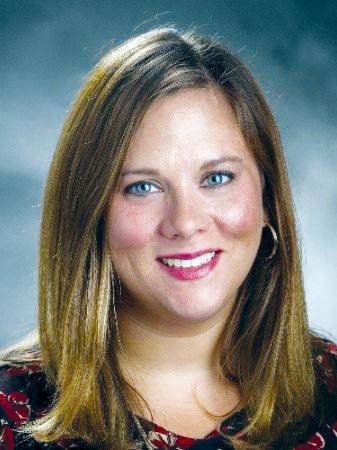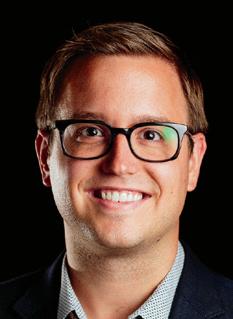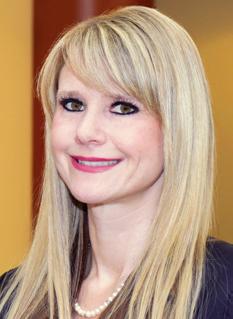
10 minute read
Tranq dope
From page 1 to the drug. One clue is if the patient is in the midst of an acute overdose and unresponsive to the opiate reversal medication naloxone. Black wounds are another.
“I think the big thing that we’re seeing are people that show up with these really bad wounds, something called eschar, which is necrotic or black wounds,” Risler says. The wounds, much like those from thermal or chemical burns, pose risks for infection and disfigurement. The wounds can require intense and long-term medical care.
Worsening epidemic
The spike in prevalence of xylazine in street drug supplies of opiates is exacerbating an unchecked epidemic that already claims an alarming number of lives. The Centers for Disease Control and Prevention says 80,816 fatal overdoses — 75% of all overdose deaths — in 2021 involved opioids. The number of opioid-related fatal overdoses in 2010 was 21,088.
A report published in April 2022 in the journal Drug and Alcohol Dependence says xylazine is increasingly present in overdose deaths. In 10 jurisdictions across the nation that were studied, detection of the drug in overdose deaths went from 0.36% in 2015 to 6.7% in 2020. The highest xylazine prevalence was in Philadelphia (25.8% of overdose deaths), followed by Maryland (19.3%) and Connecticut (10.2%).
The National Institute on Drug Abuse says the number of opioid overdose deaths involving xylazine is unknown. “Most overdose deaths linked to both xylazine and fentanyl also involved additional substances, including cocaine, heroin, benzodiazepines, alcohol, gabapentin, methadone, and prescription opioids,” according to a research brief from the agency.
The brief describes xylazine as a central nervous system depressant that can cause drowsiness and amnesia. It says the drug can “slow breathing, heart rate, and blood pressure to dangerously low levels.”
Repeated use of xylazine, the institute says, is associated with skin ulcers, abscesses, infections that can extend into bones and related complications. The institute says people report injecting, snorting, swallowing and inhaling drugs containing xylazine.
Labs can use additional analytical processes to detect xylazine in blood. Toxicology results from patients who fatally overdosed in Philadelphia and other drug hotspots across the nation show increasing evidence of xylazine abuse, the institute says. And deaths involving xylazine have been spreading westward from an epicenter in Northeastern states.
Research suggests that people suffering from substance use disorder began using xylazine in Puerto Rico in the early 2000s. Then the drug found its way into the opiates being sold illicitly in cities with large Puerto Rican populations. Users report that xylazine prolongs the euphoric effects of fentanyl, the synthetic opioid that is largely blamed for the widening overdose epidemic.
Philadelphia’s Department of Public Health says xylazine was first detected in the street drug supply there in 2006. By 2021, the agency reports, 90% of street opioid samples contained xylazine. The number of fatal overdoses in Philadelphia in which xylazine was detected spiked from 15 in 2015 to 434 in 2021.
FDA issues alert
Still, xylazine remained largely under the national radar until last November, when the Food and Drug Administration issued a warning to health care professionals. The warning says the agency is aware “of increasing reports of serious side effects from individuals exposed to fentanyl, heroin, and other illicit drugs contaminated with xylazine.”
The warning notes that naloxone may not reverse the effects of opioid overdose when xylazine is present. In such cases, the FDA says clinicians “should provide appropriate supportive measures.”
Risler says that’s what he and his colleagues do at Nazareth, a Trinity Health hospital in a working-class section of north Philadelphia. Supplemental oxygen to counter suppressed breathing is one of the supportive measures Nazareth clinicians provide to patients. Some patients with life-threatening respiratory suppression require intubation.
Because patients who have taken xylazine along with an opioid usually have been unconscious for a while when they are brought into the ER, Risler says when they regain consciousness the rush of the opioid has most likely worn off or been reversed by naloxone. That can leave them in what he describes as withdrawal with intense drug cravings.
“It’s just this tough balance between making sure that they survive an acute overdose and then convincing them that we’re here to help them and try to get them the care they need,” Risler says.


Nazareth has social workers in the ER who can provide warm handoffs to rehab programs. It sends kits with two doses of naloxone home with patients who are abusing opioids.
On the alert
In St. Louis, Drs. Steven Lorber and Mick Kilkelly haven’t seen evidence of xylazine use in patients being treated for drug overdose at SSM Health Saint Louis University Hospital.
“It’s probably here,” says Lorber, SSM Health Saint Louis University Hospital’s chief of emergency medicine. “It’s just that we’re not seeing it because we’re not looking for it.”



Given the uptick in xylazine’s presence in street drugs elsewhere, Lorber and Kilkelly are on the alert.
Kilkelly, division chief of adult anesthesiology and medical director of SSM Health Saint Louis University Hospital’s operating rooms, points out that heroin and methamphetamine have long been cut with baking soda, baby powder and other substances that don’t have much of an impact on users.
“But this stuff (xylazine) does create these devastating wounds that take a tremendous amount of time, energy and effort and health care resources to heal,” he says.
Demand and supply Lorber and Kilkelly say xylazine’s spread in the street drug supply is to be expected for several reasons. One is that there seems to be demand for the drug. Another is that xylazine is currently not classified as a controlled substance. Even if drug enforcement agents or police find a trafficker with a stash of xylazine, the possession will not prompt charges.
“It’s not illegal to possess xylazine,” Kilkelly says. “You can have cases of this stuff in your trunk and get pulled over, and the officer has no legal authority to do anything.”
The doctors also say that much like fentanyl, xylazine apparently can be easily manufactured in a lab. “The purity is probably very, very high and it’s highly concentrated,” Lorber says. “So, it’s this very small amount of chemical that you need that you can then cut to make a great deal of product to sell.”
The SSM Health Saint Louis University Hospital doctors note that in the U.S., drug trends tend to start on the nation’s coasts or southern border and then move inland. They are hoping that before xylazine becomes more prevalent in the Midwest they and other care providers have time to educate themselves about how to detect the drug’s presence and treat patients who have developed dependencies to it. They also hope to get a jump start on informing the public and the substance-abusing community on xylazine’s risks.
As to how to curtail the supply of xylazine, Kilkelly and Lorber expect that federal regulators will eventually add the drug to the list of controlled substances and policymakers will make its unauthorized manufacture and possession illegal. That, they say, will spur the development and use of simple tests that can detect xylazine in drug supplies and in toxicology tests of patients being treated for overdose.
Compassionate care
In the meantime, the St. Louis doctors are looking toward the East Coast to see what best practices their peers identify for treating patients harmed by xylazine use.
Nazareth is the third hospital in Philadelphia where Risler has worked. At each one he has helped treat a population of patients with substance dependency disorders and related comorbidities.
“I think you quickly realize that none of them want to be in the position that they’re in,” he says. “It’s just these drugs are so addictive, it’s hard to get over that. We are just treating them with the most compassionate care that we can and kind of meeting them where they are and just doing everything we can to help.” leisenhauer@chausa.org
T a k e y o u r
T a k e y o u r p a ss i o n f o r p a ss i o n f o r a d v o c a c y t o a l l a d v o c a c y t o a l l l e v e l s o f l e v e l s o f h e a l t h c a r e h e a l t h c a r e
Community Health Investment Certificate
Community Health Investment Certificate
Robots
From page 1
Jackee Bauch, executive director of support services at Mercy Jefferson and Mercy Hospital South in St. Louis County, Missouri, has helped oversee the robot pilot project. She says while patients and visitors still sometimes do a double take when the machines roll past, co-workers have become accustomed to the robotic couriers.
Bauch says the machines have improved the work environment by unburdening co-workers of some tasks in order to open up more time for other duties. The robots push meal carts to patient floors where nonmedical aides pass out the food trays to patients. Robots cart medications and supplies to medical units to recapture time pharmacy and clinical staff can devote to patient care. They assist housekeeping staff by hauling loads of dirty linen to the laundry.
Bauch says robots have not replaced any co-workers, just taken over some of the more mundane tasks. “We want to treat our co-workers with dignity and this is one way to do it because it allows them to spend more time with patient care,” she says. “That’s why they come here to work, to take care of patients and serve them.”
Rise of robotic technology
Robotic technology factors into clinical care too. Many surgeons use robotic tools to increase surgical precision. Rehabilitation robots assist in reconditioning patients. Robotic exoskeletons allow wheelchair users to stand and walk.
Saint Joseph Hospital in Denver, part of Intermountain Health, opened in 2014 with what it called the nation’s first robotic pharmacy.
In 2020, the American Nurses Association published an 84-page case study on the use of autonomous service robots in hospitals. The white paper notes that the technology appears to be on the rise and is likely to have profound impacts on the profession.
“Regardless of the speed with which this transition will occur, robotics associated with patient care will very likely transform and revolutionize the way we support, augment, and deliver care,” the case study says.
Two hospitals within Trinity Health are piloting the use of Moxis made by Diligent Robotics for the hospital system. One is MacNeal Hospital in suburban Chicago, part of Loyola Medicine. The other is Trinity Health Oakland Hospital in Pontiac, Michigan.
Diligent Robotics, an Austin, Texas- based company founded in 2017, designs robots specifically for use in health care settings. Diligent says the number of hospitals using its Moxi robots increased from two at the start of 2022 to 14 by year’s end. Moxis logged a total of 160,000 deliveries in those facilities last year.
Jennifer Moore, nurse manager of cardiac telemetry at MacNeal Hospital, calls the two Moxis that began making rounds there in August “a great addition to our staff.”

In her unit, Moore says the Moxis cart the cardiac telemetry boxes between patient rooms and the central telemetry hub. The robots also ferry goods from central supply and medications from the pharmacy. Moore says Moxis usually deliver requested supplies within 10 minutes.

“This is a solution to a problem I don’t think we realized we had,” she says. “I think it has been great for our staff overall because they appreciate the time Moxi has given them to stay at the bedside.”
No replacement for the human touch
Unlike TUG robots, which from the front resemble a washing machine-sized appliance, Moxi robots have a more humanlike appearance. They are 4½ feet in height and weigh in at about 300 pounds. They have what looks like a torso with a bendable arm attached. They are topped with a rounded block about the size of a human head, complete with eye-like lights that can flash red hearts when people are around.
MacNeal staff summon and direct the Moxis via iPad kiosks at central locations in the hospital. The robots are programed for routes within and between the hospital’s two towers. Each robot has three secure drawers in its base. Access to the drawers is programed into individual workers’ electronic ID badges.
While they can’t carry on a conversation, Moxis can announce themselves with simple statements like “I’m here for a pickup.” When they’re not on a task, the devices park themselves at recharging stations.
Diligent Robotics contracts out the Moxis in packages that include programing and service. Gregg Springan, head of clinical informatics at Diligent Robotics, says the company is continually updating the Moxi software. The programing incorporates machine-learning algorithms that fine-tune the robots’ ability to navigate in their environments.
Springan says while the Moxis somewhat resemble humans, the company’s intent is not to replace flesh and blood workers. “In fact, I would argue that robots can’t replace the human touch,” Springan says.
What they can do is give workers more time to do essential tasks and bolster the efficiency of a workforce that is increasingly spread thin, he says.
Optimism and concern
The American Nurses Association case study includes input from Diligent and three hospitals piloting service robot use. The white paper reflects optimism that the devices will in the long run prove to be a blessing for nurses, as well as concerns.
“If nursing is to remain relevant, we must use our superpower of innovation and become proactively involved in charting the path for the adoption of this emerging technology, provide direction into what skills robots provide and help determine how robots are incorporated into the patient care ecosystem,” the paper says.
Springan is onboard with the notion that nurses should have input into how Moxis and other robots impact their profession. He’s a former intensive care nurse and part of a team of clinicians at Diligent who he says are “representing the voice of the medical profession” as the company continues to evolve its technology.

Proof of concept
At Mercy Hospital Jefferson, pharmacist Rachel Handrahan had reservations when the TUG robots were introduced. “I was kind of like, eh, I don’t know how that’s actually gonna work,” she recalls.

Now her pharmacy keeps two of the robots busy with deliveries day and night. One of the TUGs has multiple drawers. Handrahan can schedule a specific drop spot for each drawer. Staff at the receiving end have to use a unique ID and their fingerprints to open the drawer. At each scheduled stop, the robot will wait up to 10 minutes before automatically moving on to the next stop and then returning to their base. The robot’s runs can take more than an hour.
The other pharmacy robot has one large locked cabinet. Handrahan sends it out with deliveries that require more space, such as bags of intravenous fluids.

When the TUGs are on the units, Handrahan can monitor from her desktop their whereabouts and progress as well as who has accessed each compartment. She can even switch to a view from the cameras on the robots to see their surroundings.
Now that she’s had the robotic helpers for several years, Handrahan admits, “I do like them way more than I ever thought I would.” leisenhauer@chausa.org








